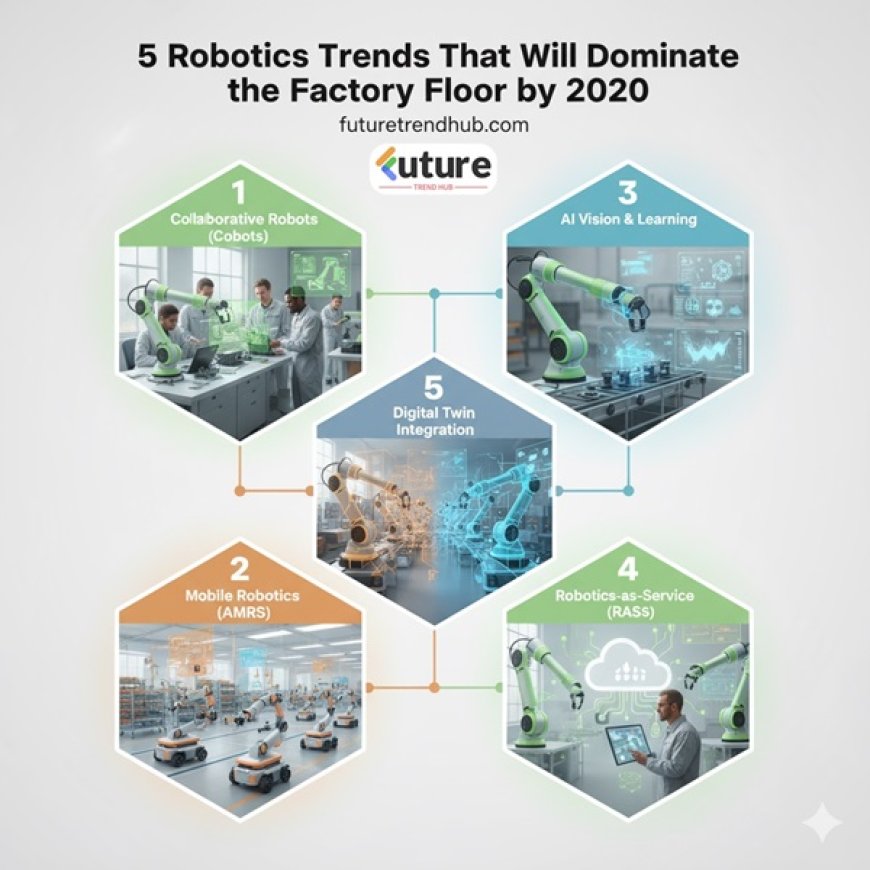5 Robotics Trends That Will Dominate the Factory Floor by 2030
Explore the top 5 robotics trends shaping the future of manufacturing by 2030 — from collaborative robots to AI-driven predictive maintenance and digital twin technology.

Introduction
Walk into a modern factory today, and you’ll notice something fascinating — machines no longer just work, they think. Robots that once followed simple, repetitive commands are now learning, adapting, and even collaborating with humans.
The industrial world is entering a new chapter, driven by AI-powered robotics, automation, and data intelligence. By 2030, factories as we know them today will look completely different — smarter, safer, and more connected than ever before.
So, what exactly is shaping this transformation? Let’s explore five major robotics trends that are set to redefine how factories operate in the next decade.
1. Collaborative Robots (Cobots): Humans and Machines as Teammates
Gone are the days when robots were caged behind safety barriers. The future belongs to collaborative robots, or cobots, designed to work side by side with humans.
These machines aren’t replacing workers — they’re helping them. A cobot can handle repetitive or heavy tasks while the human focuses on creativity, problem-solving, and supervision.
What makes cobots special is their built-in intelligence. Equipped with sensors and AI, they can sense human presence, adjust their speed, and even learn from real-time feedback.
By 2030, experts predict cobots will be as common on the factory floor as power tools are today — helping industries achieve higher productivity with fewer injuries and lower stress.
2. AI-Driven Predictive Maintenance: Fixing Problems Before They Happen
Imagine if your machines could tell you when they’re about to fail — long before they actually do. That’s not science fiction anymore; it’s called predictive maintenance, powered by AI and robotics.
Modern industrial robots are now equipped with sensors that track vibration, temperature, and performance metrics. Using AI analytics, they can detect early warning signs of wear or malfunction.
Instead of waiting for an expensive breakdown, factories can now schedule maintenance only when it’s truly needed — saving both time and money.
By 2030, predictive maintenance systems are expected to reduce equipment downtime by up to 50%, keeping production lines running smoother than ever.
3. Autonomous Mobile Robots (AMRs): The Factory’s Smart Movers
Remember those bulky conveyor belts and forklifts? They’re slowly being replaced by Autonomous Mobile Robots (AMRs) — smart, self-navigating machines that transport materials across factory floors.
Unlike traditional automated guided vehicles (AGVs) that follow fixed routes, AMRs use sensors, LiDAR, and cameras to find the most efficient path on their own.
Think of them as delivery robots inside the factory — carrying parts, tools, or finished goods wherever they’re needed, safely avoiding obstacles and people.
Companies like Amazon and BMW have already integrated hundreds of AMRs into their production and logistics systems. By 2030, these tireless movers will become the backbone of intralogistics, making factories more agile and efficient.
4. Robotics and Digital Twins: Simulating Perfection
Before you build a real production line, imagine being able to test it virtually — run simulations, identify bottlenecks, and even predict how the robots will perform in real life.
That’s exactly what digital twin technology is enabling. A digital twin is a virtual replica of physical equipment, powered by real-time data from sensors.
When paired with robotics, it becomes a powerful tool. Engineers can test robotic movements, safety protocols, and workflows digitally, without stopping the actual production.
By 2030, digital twins will not only help design smarter robots but also create fully synchronized factories — where the digital and physical worlds operate in harmony.
5. Sustainable and Energy-Efficient Robotics: Greener Factories Ahead
Sustainability isn’t just a buzzword anymore — it’s a business necessity. As industries move toward net-zero goals, robotics will play a key role in reducing energy consumption and waste.
Next-gen robots are being built with energy-efficient motors, lightweight materials, and AI systems that optimize power use. Some even regenerate energy during operations — just like hybrid cars!
These intelligent robots can also help monitor emissions, reduce material waste, and manage resources better, making manufacturing greener and more responsible.
By 2030, eco-friendly robotics will become a core part of smart factory ecosystems, balancing productivity with sustainability.
The Human Side of the Robot Revolution
While all this technology sounds futuristic, one thing remains constant — humans will still be at the center of innovation.
Robots may take over routine tasks, but creativity, decision-making, and emotional intelligence will always require a human touch. The factories of the future won’t be “robot-only” — they’ll be human-plus-robot environments, where both work together seamlessly.
This shift will also create new roles: robot trainers, automation analysts, and data engineers — jobs that didn’t exist a decade ago.
Conclusion
By 2030, the factory floor will look less like a traditional assembly line and more like a smart, adaptive ecosystem. Collaborative robots will be working shoulder to shoulder with humans. Predictive systems will prevent downtime before it happens. Mobile robots will keep materials flowing efficiently. And sustainability will guide every move.
This isn’t just the future of manufacturing — it’s the future of how we work, build, and innovate.
The rise of robotics is not about replacing people; it’s about giving industries the power to do more with less, and giving humans the freedom to focus on what they do best — imagining, improving, and leading.







